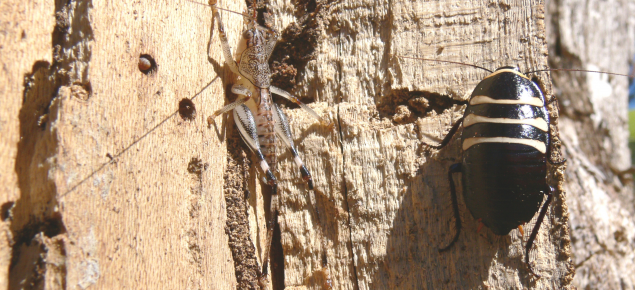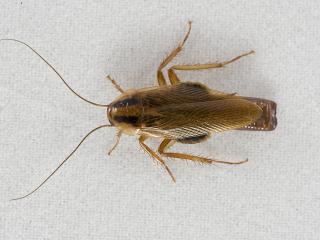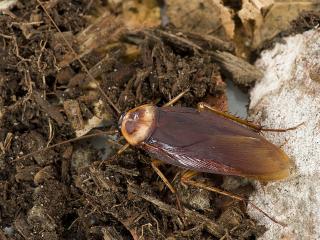About cockroaches
They are known as a pest insect because they cohabit with humans in dwellings, especially in kitchens, where some species can carry disease organisms like Salmonella, which may cause gastroenteritis, dysentery, tuberculosis, hepatitis and typhoid fever.
Cockroaches can also carry viruses and eggs of worm parasites and the health threat posed by cockroach populations closely cohabiting with humans justifies their control.
Most native Australian cockroaches are found among the vegetation, leaf litter and soil of undisturbed habitats. There are only a small number of pest cockroaches, most are introduced species and this article describes the main pest cockroaches and suggests preventative and practical control methods.
Biology
After mating, eggs develop in the female in a purse-shaped egg case called the ootheca, which can contain between 12 and 40 eggs, depending on the species. The ootheca may be glued to a surface and left unattended or dropped just prior to hatching.
Immature cockroaches, referred to as nymphs, emerge from the egg cases. Nymphs look like small versions of the adults but do not have wings. The nymphs grow into adults through a number of moults which takes between two months and a year, and then live as adults from a few months to over a year, depending on the species. During her adult life, a female may produce between 5 and 30 oothecae.
Cockroaches are omnivorous, which means they eat virtually any organic matter.
The pest species of cockroach are gregarious, forming groups of adults and immature nymphs. They are mostly nocturnal creatures, hiding during the day. Cockroach activity during the day indicates a cockroach overpopulation. Most pest species need ready access to water.
Types of pest cockroaches
German cockroach
The body of an adult German cockroach is about 12mm long. It is beige to light brown in colour, with two dark stripes on the back of its head. It is the most widespread and successful cockroach and is commonly found in homes, restaurants, food processing plants, supermarkets and warehouses.
The German cockroach seeks warm moist conditions with access to food and water. They are common in domestic kitchens and commercial food-handling areas and are active at night, hiding during the day in dark, secure places. They seek out moist areas near sinks, dishwashers, cracks and crevices in the pantry, kitchen and bathroom cupboards, under electrical, heating and cooking appliances and inside wall cavities or behind skirting boards for their homes. They can often be seen on the undersides of drawers or benchtops.
Although adults are winged, this cockroach rarely flies. Dispersal is mainly through individuals or egg cases attached to food containers, cartons, fridges, stoves and other appliances or materials brought into a building.
German cockroaches do not thrive in locations away from humans or human activity. The German cockroach is the most prolific breeder of cockroach species. The female lives up to six months and carries an egg capsule containing 30 to 40 eggs. Development from egg to adult can occur in 45 days, during which the nymphs moult six times.
Because of the rapid breeding, a small initial infestation can become a major problem within a few months.
American cockroach
The American cockroach is the largest of the cockroach pest species. Its adult body is 30 to 50mm in length and is reddish brown with a yellowish band behind the head. It lives in warm, moist, dark conditions – indoors in colder regions, but mainly outdoors in warmer regions. Its preferred daytime habitats are the warm, dark, moist locations associated with sewers, and wall, roof and subfloor voids. They often congregate around hot water pipes, fridge motors, boilers and other heating appliances.
The American cockroach prefers decaying, organic matter, but will feed on a wide variety of plant and animal material. They fly readily and are attracted to lights, especially on warm summer nights. They can often be seen around stormwater drains during summer.
The female life span is up to two years. Even though the incubation period of eggs is five to eight weeks, under ideal conditions they quickly reach plague proportions. An adult without food or a water source may survive for about two to three months.
Native Australian black cockroach
The native Australian black cockroach is commonly found indoors during the summer months. It is black with a white margin and grows to 35mm in length and is wingless, even in the adult stage.
This cockroach is primarily an outside species which feeds on decaying plant material. It is not a recognised carrier of disease because of its preference for leaf litter over human refuse. In summer it comes inside to shelter from the heat.
Brown banded cockroach
The relatively small, brown banded cockroach is pale brown with very pale bands across the thorax and abdomen. Unlike the other pest species it can live in dry situations and may be active throughout the building, rather than being restricted to the kitchen and other damp areas. They are particularly suited to our modern technology and are often found in electrical equipment such as computers, keyboards, microwave ovens, wardrobes, dressers, cabinets and behind bookshelves. Their wide dispersal within premises can make control difficult.
Its egg cases are glued to surfaces and the hatched nymphs require two to four months to develop into adults. Adults can live for up to six months.
The brown banded cockroach may fly if disturbed and it is not unusual for it to be observed during daytime.
Cockroach prevention
Hygiene is the single most important factor in managing cockroach problems. Making access to food and water difficult constrains their normally high population growth.
Older buildings can be troublesome because old plumbing piping and equipment can leak and create damp conditions ideal for cockroaches. Fixing leaking equipment and sealing access points that allow cockroaches entry to the home are important steps in reducing cockroach numbers.
Doors and windows should be kept closed or screened at night to prevent cockroaches being attracted to lights and simply flying in.
Other common sense methods to reduce cockroach problems include:
- Cleaning food-contaminated surfaces like benches and plates and not leaving them dirty overnight.
- Reducing water availability overnight, mopping up puddles and fixing dripping taps and seals around sinks.
- Storing food in tightly closed, cockroach-proof containers.
- Inspecting incoming food for egg cases.
- Storing rubbish in tightly closed containers.
- Filling cracks and crevices that can act as shelter.
- Inspecting and cleaning surfaces below food processors and toasters.
- Cleaning ovens, cupboards and shelves.
- Avoiding dropping crumbs and spilling sweet drinks in the vicinity of computers and keyboards.
Chemical control
If chemical control is used, apply the chemical to ensure that the target insects have contact with it.
Surface-sprays are residual and should be applied to cracks, crevices and voids that may serve as a home for cockroaches. Pay particular attention to rubbish bins and receptacles. The bases of bins can be treated to ensure cockroaches contact the insecticide on their way to gaining access to the bin contents.
When treating cupboards, treat all the internal angles so that cockroaches must contact the treated surface when moving from a shelf to a wall and vice versa.
For German cockroaches, apply the spray to the undersides of drawers and shelves. Do not treat surfaces where food is handled and which regularly get washed down. If storage areas are treated remove food before treatment and replace after the treatment has dried. These surfaces may stay insect-active for months. Surface-sprayed insecticides usually act on contact as the insecticide is absorbed by the insect through the cuticle.
Spray around rubbish bins, sewer and drain inspection grids and house access areas like doorways and windows. Suitable surface sprays include the synthetic pyrethroids containing deltamethrin, imiprothrin and cypermethrin, imiprothrin and detamethrin, alpha-cypermethrin, bifenthrin and esfenvalerate and beta cyflurin with the systemic neonicotinoid imidacloprid.
Dusts contain permethrin and are used where wet sprays can be a problem and should be applied lightly. Dusts are useful near electric wiring, and where there is no likelihood of humans disturbing the dust deposit, such as in roof spaces or wall voids. Depending on the dust used, it can give months of protection.
Baits and traps can control small infestations but are usually more effective if used in conjunction with other types of management methods. However, ensure that sprays do not contaminate baits as this will make the baits repellent to the cockroaches and therefore ineffective. Baits contain indoxacarb, abamectin and fipronil and should be placed in corners and along edges (not treated with insecticide) where cockroaches travel. Traps are useful to monitor cockroach infestations as they can indicate their presence and level of activity.
Insect bombs can also be used to control cockroaches. Remove plants and pets from the home and cover fish tanks and food that can be contaminated by the sprays.
After setting off the bomb all residents should immediately leave the house for the time period specified on the product label. Follow the label's instruction on airing the home on your return and wait the specified period before moving back into the home.
Insect bombs contain products including permethrin and fenoxycarb and can penetrate areas you are unable to reach.
Control by natural enemies
Natural predators of cockroaches are various arthropods (including spiders), frogs, lizards, birds and mammals. Some wasps parasitise cockroach egg cases.



